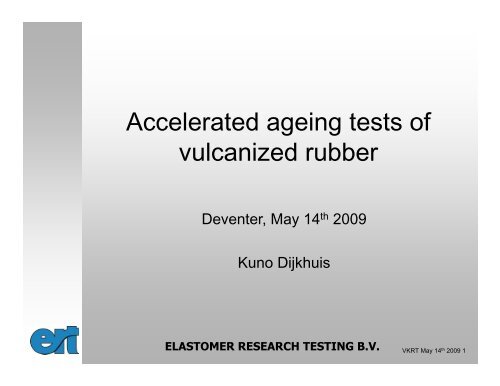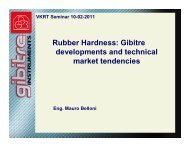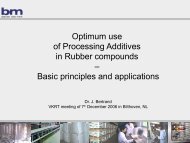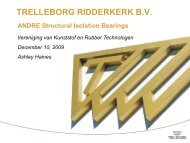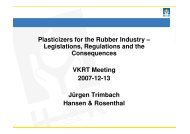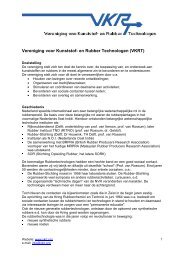Read document - VKRT
Read document - VKRT
Read document - VKRT
You also want an ePaper? Increase the reach of your titles
YUMPU automatically turns print PDFs into web optimized ePapers that Google loves.
Accelerated ageing tests of<br />
vulcanized rubber<br />
Deventer, May 14 th 2009<br />
Kuno Dijkhuis<br />
ELASTOMER RESEARCH TESTING B.V. <strong>VKRT</strong> May 14 th 2009 1
Ageing is a collective term for changes in properties<br />
of materials that occur on longer term storage,<br />
without the action of chemicals, that lead to partial<br />
or complete degradation<br />
These changes can occur in form of degradation<br />
processes, embrittlement-, rotting-, softening and<br />
fatigue processes, and/or static crack formation<br />
ELASTOMER RESEARCH TESTING B.V. <strong>VKRT</strong> May 14 th 2009 2
Influence on ageing resistance<br />
1) Type of polymer<br />
- Saturated or unsaturated polymer backbone<br />
2) Type of vulcanization system<br />
- Crosslink density and distribution<br />
3) Type of antidegradant<br />
- staining or non-staining<br />
- fatigue- , oxygen or ozone resistant<br />
ELASTOMER RESEARCH TESTING B.V. <strong>VKRT</strong> May 14 th 2009 3
Ageing factors causing degradation<br />
• Oxygen<br />
• Heat<br />
• Ozone<br />
• Dynamic fatigue<br />
• Light and weathering<br />
• Moisture and/or steam<br />
• Solvents and/or chemicals<br />
ELASTOMER RESEARCH TESTING B.V. <strong>VKRT</strong> May 14 th 2009 4
Oxygen<br />
Depending on the type of rubber oxygen can:<br />
- cause molecular chain cleavage, whereby the<br />
molecular network is “loosened” (degradation,<br />
softening)<br />
- NR, IR, IIR<br />
- cause crosslinking, whereby a higher crosslink<br />
density is effected (hardening, embrittlement)<br />
- SBR, NBR, CR, EPDM<br />
ELASTOMER RESEARCH TESTING B.V. <strong>VKRT</strong> May 14 th 2009 5
Ageing factors causing degradation<br />
• Oxygen<br />
• Heat<br />
• Ozone<br />
• Dynamic fatigue<br />
• Light and weathering<br />
• Moisture and/or steam<br />
• Solvents and/or chemicals<br />
ELASTOMER RESEARCH TESTING B.V. <strong>VKRT</strong> May 14 th 2009 6
Oxygen in combination with heat<br />
- Heat accelerates oxidation and the effects of<br />
oxidation are observed sooner and more<br />
severe as the temperature increases<br />
- At low temperatures oxygen uptake is roughly<br />
linear, while at higher temperatures it<br />
changes to a autocatalytic reaction<br />
ELASTOMER RESEARCH TESTING B.V. <strong>VKRT</strong> May 14 th 2009 7
Heat stability and crosslink length<br />
• Sulphur links exhibit increasing bond energies with<br />
decreasing sulphur content<br />
• Vulcanizates with high bond strength crosslinks<br />
(C-C bonds) obtain a significantly better heat<br />
resistance than those with crosslinks of lower bond<br />
strength (C-S X -C bonds)<br />
• Vulcanizates with shorter crosslinks (semi-EV, EV,<br />
sulphur donor and peroxide systems) have generally<br />
better heat stability than those with polysulphudic<br />
crosslink (CONV vulcanization)<br />
ELASTOMER RESEARCH TESTING B.V. <strong>VKRT</strong> May 14 th 2009 8
• Geer en cell ovens<br />
Heat ageing<br />
ISO 188<br />
• Results are expressed in change (%) in:<br />
– Hardness<br />
– Stress-strain properties<br />
– Tear resistance<br />
ELASTOMER RESEARCH TESTING B.V. <strong>VKRT</strong> May 14 th 2009 9
Temperature resistance of some<br />
elastomers<br />
ELASTOMER RESEARCH TESTING B.V. <strong>VKRT</strong> May 14 th 2009 10
Life-time estimation<br />
ISO 11346<br />
– 100% certainty can only be obtained by actual longterm<br />
testing<br />
– Rate of chemical reaction normally increases with<br />
increase in temperature<br />
– Exposing test pieces to a series of elevated<br />
temperatures can obtain the reaction rate of<br />
degradative mechnisms<br />
– Extrapolating to the temperature of use gives an<br />
estimation of the life-time<br />
ELASTOMER RESEARCH TESTING B.V. <strong>VKRT</strong> May 14 th 2009 11
Arrhenius equation<br />
– The Arrhenius equation can be used for properties<br />
where only chemical degradation occurs<br />
lnK(T)<br />
= B −<br />
– At least three temperatures and three time-periods<br />
should be taken<br />
– Temperatures should be chosen in such a way, that the<br />
threshold value is reached within the time-periods<br />
E<br />
RT<br />
ELASTOMER RESEARCH TESTING B.V. <strong>VKRT</strong> May 14 th 2009 12
Life-time estimation<br />
ISO 11346<br />
(■): 70°C; (●): 80°C; (▲): 90°C; (▼): 100°C; (◄): 110°C; (►): 120°C<br />
and (♦): 130°C<br />
ELASTOMER RESEARCH TESTING B.V. <strong>VKRT</strong> May 14 th 2009 13
Life-time expectancy<br />
Rubber<br />
Life-time expectancy in years at different temperatures<br />
30°C 40°C 50°C 60°C 70°C 80°C<br />
1 9.9 4.3 2.0 1.0 0.5 0.3<br />
2 28 10.9 4.5 2.0 0.9 0.4<br />
3 132 44 15.5 5.8 2.3 1.0<br />
4 4641 874 182 42 10.4 2.8<br />
ELASTOMER RESEARCH TESTING B.V. <strong>VKRT</strong> May 14 th 2009 14
Ageing factors causing degradation<br />
• Oxygen<br />
• Heat<br />
• Ozone<br />
• Dynamic fatigue<br />
• Light and weathering<br />
• Moisture and/or steam<br />
• Solvents and/or chemicals<br />
ELASTOMER RESEARCH TESTING B.V. <strong>VKRT</strong> May 14 th 2009 15
Ozone<br />
• Ozone attack occurs via reaction of ozone with the<br />
unsaturated bond double bonds break and<br />
cracks are initiated<br />
• Without extension of the vulcanizates cracks are not<br />
formed<br />
• Cracks appear slowly and perpendicular to the<br />
direction of the applied stress<br />
• Speed of crack formation depends on temperature,<br />
ozone concentration and relative humidity<br />
ELASTOMER RESEARCH TESTING B.V. <strong>VKRT</strong> May 14 th 2009 16
Ozone resistance<br />
ISO 1431-1<br />
ELASTOMER RESEARCH TESTING B.V. <strong>VKRT</strong> May 14 th 2009 17
Effect of anti-ozonant<br />
Control TMQ 6PPD<br />
ELASTOMER RESEARCH TESTING B.V. <strong>VKRT</strong> May 14 th 2009 18
Oxygen vs. Ozone degradation<br />
Oxygen degradation<br />
Ozone degradation<br />
- Mass effect<br />
- degradation takes place in<br />
whole rubber article by<br />
diffusion of oxygen<br />
-Slow reaction<br />
- Autocatalytic reaction:<br />
- low levels already start the<br />
oxidation<br />
- Surface effect<br />
-Very quick reaction<br />
-Increased by stress<br />
ELASTOMER RESEARCH TESTING B.V. <strong>VKRT</strong> May 14 th 2009 19
Ageing factors causing degradation<br />
• Oxygen<br />
• Heat<br />
• Ozone<br />
• Dynamic fatigue<br />
• Light and weathering<br />
• Moisture and/or steam<br />
• Solvents and/or chemicals<br />
ELASTOMER RESEARCH TESTING B.V. <strong>VKRT</strong> May 14 th 2009 20
Fatigue<br />
– When rubber is subjected to prolonged mechanical<br />
stress, cracks will slowly develop on the surface,<br />
ending in a complete rupture of the article<br />
– The cracks develop perpendicular to the stress<br />
direction<br />
– Higher temperatures and higher frequencies<br />
accelerate crack formation<br />
– Fatigue is a combination of both physical and<br />
oxidative processes<br />
ELASTOMER RESEARCH TESTING B.V. <strong>VKRT</strong> May 14 th 2009 21
Fatigue resistance and crosslink length<br />
• Fatigue cut growth resistance is larger in<br />
vulcanizates with longer crosslinks<br />
• Cut growth is slowed with increasing X in C-S X -C<br />
• High sulphur systems clearly give better fatigue<br />
resistance than those which are sulphur free<br />
ELASTOMER RESEARCH TESTING B.V. <strong>VKRT</strong> May 14 th 2009 22
Fatigue testing<br />
ELASTOMER RESEARCH TESTING B.V. <strong>VKRT</strong> May 14 th 2009 23
De Mattia flex test<br />
ISO 132<br />
frequency<br />
= 5 Hz<br />
ELASTOMER RESEARCH TESTING B.V. <strong>VKRT</strong> May 14 th 2009 24
De Mattia flex tester in action<br />
-Crack formation<br />
-Crack growth (L/L+2, L+2/L+6, L+ 6/L+10)<br />
ELASTOMER RESEARCH TESTING B.V. <strong>VKRT</strong> May 14 th 2009 25
Fatigue-to-failure test<br />
ISO 6943<br />
-After how many cycles do the samples break?<br />
-What is the final deformation (tension set) after the test?<br />
ELASTOMER RESEARCH TESTING B.V. <strong>VKRT</strong> May 14 th 2009 26
Fatigue-to-failure<br />
• Compound fatigue performance is measured at<br />
constant extension ratios (or constant strain<br />
energies)<br />
• Dumbbell specimens are subjected to a repeated<br />
strain cycle and the number of cycles to failure is<br />
recorded<br />
• Frequency = 1.6 Hz<br />
ELASTOMER RESEARCH TESTING B.V. <strong>VKRT</strong> May 14 th 2009 27
Ageing factors causing degradation<br />
• Oxygen<br />
• Heat<br />
• Ozone<br />
• Dynamic fatigue<br />
• Light and weathering<br />
• Moisture and/or steam<br />
• Solvents and/or chemicals<br />
ELASTOMER RESEARCH TESTING B.V. <strong>VKRT</strong> May 14 th 2009 28
Light and weathering<br />
• Sunlight promotes free radical oxidation at the rubber surface<br />
resulting in a film of oxidized rubber<br />
• A system of small and unoriented connected cracks can<br />
develop on the surface: elephant skin formation<br />
• Heat and humidity then accelerate a crazing effect giving a<br />
chalking appearance<br />
• Black stocks are more resistant due to better high energy<br />
radiation absorption characteristics of carbon black<br />
ELASTOMER RESEARCH TESTING B.V. <strong>VKRT</strong> May 14 th 2009 29
Light and weathering<br />
• Light spectrum (UV, visible and IR) discolouration<br />
• UV light polymer degradation<br />
ELASTOMER RESEARCH TESTING B.V. <strong>VKRT</strong> May 14 th 2009 30
Light and weathering<br />
ISO 4892-2<br />
Influenced by:<br />
-Temperature<br />
-Relative humidity<br />
-Spraying (demi-water)<br />
-”Acid rain” (acid solution)<br />
ELASTOMER RESEARCH TESTING B.V. <strong>VKRT</strong> May 14 th 2009 31
Ageing factors causing degradation<br />
• Oxygen<br />
• Heat<br />
• Ozone<br />
• Dynamic fatigue<br />
• Light and weathering<br />
• Moisture and/or steam<br />
• Solvents and/or chemicals<br />
ELASTOMER RESEARCH TESTING B.V. <strong>VKRT</strong> May 14 th 2009 32
Steam and/or moisture<br />
• In the presence of heat, various reactions can take<br />
place in the absence of oxygen, i.e. in steam or<br />
immersed in oil<br />
• slower structural changes than in oxygen, for oxidation<br />
sensitive rubbers → allows application at higher<br />
temperatures<br />
• breaking of C-N-, C-O-, resp. Si-C bonds in for example<br />
the hydrolyzable rubbers, AU, EVM and Q<br />
ELASTOMER RESEARCH TESTING B.V. <strong>VKRT</strong> May 14 th 2009 33
Ageing factors causing degradation<br />
• Oxygen<br />
• Heat<br />
• Ozone<br />
• Dynamic fatigue<br />
• Light and weathering<br />
• Moisture and/or steam<br />
• Solvents and/or chemicals<br />
ELASTOMER RESEARCH TESTING B.V. <strong>VKRT</strong> May 14 th 2009 34
Chemical resistancy<br />
ISO 1817<br />
EPDM in ASTM oil 3<br />
Results expressed as change in:<br />
- hardness, stress-strain properties, mass, volume, density<br />
ELASTOMER RESEARCH TESTING B.V. <strong>VKRT</strong> May 14 th 2009 35


